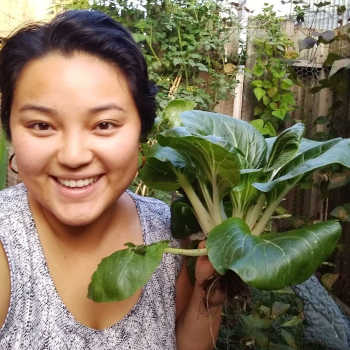Meet Our Team

Kevin Espiritu
Founder & CEO
As a self-taught gardener, Kevin has spent over a decade producing educational gardening content across YouTube, TikTok, Instagram, Facebook, the Epic Gardening podcast, and the Epic Gardening website.

Kevin Espiritu
Founder & CEO
Kevin Espiritu is the founder and CEO of Epic Gardening, the world’s most-followed gardening brand and online garden store. As a self-taught gardener, Espiritu has spent over a decade producing educational gardening content across YouTube, TikTok, Instagram, Facebook, the Epic Gardening podcast, and the Epic Gardening website.
He’s amassed over 3.6 million social media followers, 11 million podcast downloads, and 42 million blog visits. Additionally, Espiritu has authored two books, ‘Field Guide to Urban Gardening: How to Grow Plants, No Matter Where You Live” and “Grow Bag Gardening: The Revolutionary Way to Grow Bountiful Vegetables, Herbs, Fruits, and Flowers in Lightweight, Eco-friendly Fabric Pots.”
Kevin currently lives in San Diego, California, at his Epic Homestead. His favorite plants are beans and peas.

Jason Wilson
Head of Search
Jason is a digital marketer and hobby gardener. He lives rurally with his family in Middle Tennessee and enjoys growing dahlias in his garden with his family.

Jason Wilson
Head of Search
Jason Wilson started his online journey working in digital marketing before combining his marketing passion with his enthusiasm for gardening and self-sustainability. He currently lives on acreage in middle Tennessee, where he and his family enjoy growing seasons that are long and productive.
Jason started his growing journey predominantly in growing zone 9b, with experience planting and growing more heat tolerant plants. Now in zone 7a, his favorite plants are his beloved dahlias and his garden squash. His goal when he joined Epic Gardening was to combine his hobby gardening knowledge with his professional marketing skills to help create a gardening resource for gardeners across all skill levels.

Lorin Nielsen
Head Horticulturist
Lorin is a horticulturist and certified naturalist in the state of California. She enjoys vegetable gardening and native plants.

Lorin Nielsen
Head Horticulturist
Hi! I’m Lorin. As a kid, I planted my first plant under the careful tutelage of my mom. However, the neighbor’s cherry tomatoes were what really had my attention. The tastiest food is always the stuff you grow yourself… or maybe it’s the stuff you pilfer from the neighbor’s garden as a kid. Either way, I was hooked from that moment.
For years, I’ve had my hands buried deep in the soil no matter where I was. While living in an apartment, my balcony was a green spot in an urban landscape. I’ve rented plots at community gardens to grow insanely-tall tomato plants and other food crops. Now, I’ve reclaimed most of a previously weed-filled yard from invasive species and have turned it into a family food garden.
As a result, I’ve developed a passion for soil-building and composting and could talk your ears off about vermicomposting and bokashi. I’m a huge advocate for raised bed gardening for people with physical limitations, and every tiny sprout in my seed starting trays brings a huge smile to my face.
For years I’ve been a writer and an editor, and have truly enjoyed my time as the Editor-In-Chief of Epic Gardening — but have moved on to a position as the company’s Head Horticulturist and couldn’t be happier! I’m also a California Master Naturalist; this helps me to get a more holistic view of how various ecosystems impact gardening and how our gardens change the ecosystem.
Every day is a chance to learn, grow, and share everything I’ve experienced with all of you. Even better, I never stop learning new things, and that strengthens my love of gardening. It’s a combination of artistry meeting science, paired with a whole lot of healthy exercise. What more could you need?
I’m absolutely thrilled to share my lifetime of experience in organic gardening, soil-building and remediation, raised bed tricks, and more. No matter if you have a foot of space or an acre, you can grow in it!

Danielle Sherwood
Managing Editor
Danielle is an avid gardener, writer, and editor. She is an expert in rose maintenance, and is in the process of earning her Master Gardener certification.

Danielle Sherwood
Managing Editor
Danielle is an avid gardener and rose enthusiast originally from the Pacific Northwest. She now gardens in the high desert of Washington State. She comes from a long line of hobbyist and professional gardeners, and has fond childhood memories of gardening with her mother and helping her grandfather prepare veggies for the farmer’s market.
Danielle has experience with a wide variety of roses and companion plants. Her personal favorites at home are ‘Eden’ and ‘Teasing Georgia’.
A mom of 4, Danielle is passionate about sharing the magic of gardening with kids. For many years, she taught teens the value of growing their own food and beautifying the earth at her local High school’s community garden.
Her biggest gardening challenge is convincing her two dogs, Louisa and Pinecone, to keep out of the roses after applying manure. Danielle is an advocate for planting keystone native species and creating wildlife habitat along with roses in the garden. She is in the process of earning her Master Gardener certification and after penning much of the rose content at Epic Gardening, now acts as the Managing Editor.

Sarah Jay
Staff Writer & Content Strategist
Sarah's goal is to empower readers of gardening publications to grow practical and efficient gardens using native and non-native plants.

Sarah Jay
Staff Writer & Content Strategist
I grew up in my family’s gardens in Long Island and near Houston, Texas. I moved north from Houston for college at the University of North Texas where I earned my Bachelor’s in English Literature and Master’s in Applied Anthropology. It was during my time at college that I began studying plant medicines.
Moving from the Gulf Coast to North Texas was a bit of a soil shock, but working within these limitations has helped sculpt me into the gardener I am today. I spend a lot of time researching soil, native/adapted plants, and ecological systems that make up our world. My goal in life is to empower readers of gardening and herbal publications to grow gracefully, practically, and efficiently so they can achieve desired results in their gardens.
Currently, I’m focused on the ecology of the North Texas Cross Timbers and Blackland Prairie regions where I live. This past year I’ve been certified as a Texas Master Naturalist. In my yard, I conducted experiments with sheet mulching, Hügelkultur, and varying forms of companion planting. I enjoy building pollinator corridors and growing wildflowers in my yard. I spend time on the prairie and hope to have an opportunity in the future to restore a small piece of land of my own. When I’m not immersed in the bounty of the earth, I’m making music, practicing Kung-fu, and studying various religions.

Madison Moulton
Staff Writer & Content Strategist
Madison is a professional writer and passionate gardener. She's been featured by Architectural Digest and Real Homes for her tropical plant knowledge.

Madison Moulton
Staff Writer & Content Strategist
Madison is a writer, editor and life-long plant lover. After discovering an obsession with indoor gardening, she transformed her passion for plants into a career, contributing to various online and print publications in the gardening sphere. Through her writing, Madison hopes to encourage new gardeners to garden with the plants and the planet in mind.
Madison has written for many major online gardening publications and is one of our top contributing writers at All About Gardening. She continues to write for other gardening publications like Rural Sprout, and Gardener Magazine. She’s also been featured by Real Homes, and Architectural Digest for her in-depth experience with tropical plants. When Madison isn’t writing for us, you can catch her in her home country of South Africa planting in her garden.

Logan Hailey
Editor, Writer, and Organic Gardener
Logan is a writer, and former full-time ecological farmer. She has a BS in sustainable horticulture, and is passionate about organic gardening.

Logan Hailey
Editor, Writer, and Organic Gardener
Logan Hailey is a passionate garden writer and former full-time ecological farmer turned digital nomad. She is an expert in organic gardening with a BS degree in Sustainable Horticulture. She loves vegetables and has grown many different plants in her lifetime.
Logan is one of our top authors, and has written much of our organic gardening content at All About Gardening. She’s been featured in MSN.com, Thrillist.com, Apartment Therapy, and other major news media outlets. When she’s not writing, or gardening, you can keep up with her adventures on Instagram @naturallylogan, or on her podcast, The Soil Collective

Jill Drago
Gardening Expert & Writer
Jill is a hobby gardener and mom. She earned her B.S. in Environmental Horticulture and Turfgrass Management from the University of Rhode Island.

Jill Drago
Gardening Expert & Writer
Jill is currently a hobby gardener and stay at home mom. Her love for gardening came from a high school job at a local garden center. Jill then earned her Bachelor of Science in Environmental Horticulture and Turfgrass Management from the University of Rhode Island in 2007.
Jill has spent her years post college as a plant recorder at a botanical garden, golf course horticulturist, and high-end gardener. She specializes in coastal plantings in zone 6b and loves hydrangeas.

Kaleigh Brillon
Plant Lover & Garden Writer
Kaleigh Brillon is a garden writer with a bachelor's degree in English. She has a love for all types of outdoor and indoor plants.

Kaleigh Brillon
Plant Lover & Garden Writer
I attribute my love of plants to my grandfather. He and my grandmother always had a vegetable garden, and I spent a lot of my time at their house looking at the plants and making mud pies with the nursery pots. Eventually, my parents started their own garden, and I always ended up being the one caring for it the most.
It wasn’t until a plant biology class in my second year of college that I became obsessive about plants. I had to grow zinnias in the greenhouse for an assignment, and that greenhouse quickly became my favorite place to be. My project partner let me have her zinnias when the assignment was over, and from that point on, I’ve always had something growing. Every year I grow vegetables in a raised bed and wildflowers in flower beds.
I’m a freelance writer living in west Texas. I graduated with an English degree, but I often wish I had gone the route of studying plants. If I’m not in my garden, I watch videos about plants while crocheting or attempting to knit.

Kelli Klein
Gardening Expert and Writer
Kelli is a garden writer that is passionate about native plants and wildflowers. She gardens with a goal of supporting her local pollinator ecosystem.

Kelli Klein
Gardening Expert and Writer
I grew up in Chicago with two parents who loved to garden. My dad was an avid vegetable gardener who loved his homegrown jalapeños, and my mom tended to many varieties of flowers. In my early 20s, I moved out on my own and almost immediately missed having a yard and a garden to spend time in. I filled every window sill in my condo with plants. I would even start little seedlings in the windows and then bring them over to my parents’ yard to transplant them out.
Eventually, my friend, who lived down the street, gave me free rein in his backyard. I put in a raised bed and designed my first vegetable garden from scratch. After that, I knew how important it was to me to always find a way to have a garden, and the goal of one day growing all of my food began to take shape. An interest in growing my food also blossomed alongside an interest in cooking the foods that I was harvesting. I attended culinary school and have been working in the food industry for the last 10 years.
In 2017 I bought a house in Colorado and have been slowly turning the outdoor space into my dream garden. Each year I add something new. Last year I tore up the lawn on the side of the house and added 5 new raised beds. The year before that I had my property certified as a Wildlife Habitat through the National Wildlife Federation. My entire front yard is landscaped with native plants and wildflowers, and providing habitat for animals and food for pollinators is very important to me. This year my goal is to invest in perennials and I’ll be planting my first fruit tree!

Rachel Garcia
Gardening Expert & Writer
Rachel fell in love with gardening while going to college after taking a landscape design course. She has a passion for microgreens and succulents.

Rachel Garcia
Gardening Expert & Writer
Rachel here! Even though my dad’s an avid gardener, I didn’t discover my love for it until I went to college. I took a landscape design course for an elective and was hooked – plants are amazing!
In no time, my windowsill was cramped with potted plants from the grocery store. My roommates joked that I would wake up one morning tangled in leaves. Unfortunately, they also teased me about how many of my plants died.
Luckily, I was able to cure my black thumb with lots of practice and horticulture classes. My absolute favorite was a Special Projects course where I conducted a semester-long study on succulent propagation.
During that course, I really came to appreciate how beautiful the science behind each plant is. Even now, the first thing I do when I get a new plant is research it.
Epic Gardening is a fantastic source for all gardeners and I love being part of it. Through learning and teaching, we can work to turn all black thumbs green!

Melissa Strauss
Gardening Expert & Writer
Melissa is a writer, hobby gardener, beekeeper and homemaker. She has experience with pollinator gardens and loves tending to her fruit trees.

Melissa Strauss
Gardening Expert & Writer
Melissa is a writer, hobby gardener and beekeeper who spent many years as a Language Arts teacher before pursuing life as a homemaker. Now she can be found working in her extensive pollinator garden, trolling local nurseries for unique plant specimens, tending to her chickens, honey bees, and the many fruit-bearing plants on her property. Melissa hopes to inspire other gardeners to delve into the rich and fulfilling world of pollinator gardening.
Melissa spent many years gardening in the tropical climate of South Florida where orchids are part of the natural landscape and many common houseplants are native species. In 2016, she moved to North Florida where she currently resides with her husband, three daughters, 13 chickens, thousands of honeybees and a rooster named Bruce. Melissa’s greatest gardening goal is to create a home for an abundance of hummingbirds, dragonflies, butterflies and-her personal favorite-bumble bees.

Dr. Liessa Bowen
Gardening Expert & Writer
Liessa is a garden writer with a Master’s degree in wildlife biology from Iowa State University and a PhD in forestry from North Carolina State University.

Dr. Liessa Bowen
Gardening Expert & Writer
Liessa decided at the age of 10 that she wanted to be a naturalist, and started learning everything she could about plants, animals, and ecosystems. Many years later, she earned a Master’s degree in wildlife biology (Iowa State University) and a PhD in forestry (North Carolina State University), both with an emphasis on conservation biology and birds. She has worked as a greenhouse technician, wildlife biologist, educational consultant, artist, and homeschooling mom. She’s also written for NC State University about plants and wildlife.
Liessa has special interests in native plants, gardening for wildlife, ecology, and conservation. She has maintained a garden everywhere she has lived. She currently lives in North Carolina and maintains a small urban garden with annuals, perennials, vegetables, herbs, and a persimmon tree. She also has several house plants and two rescue cats who get into everything! In her spare time, you will most likely find her wandering around in the woods with a camera.

Liz Jaros
Certified Master Gardener & Writer
Liz Jaros is a professional writer and certified master gardener. She divides her time writing garden content and running a landscape design business.

Liz Jaros
Certified Master Gardener & Writer
Liz Jaros is a professional writer and gardener who calls the Midwest home. She divides her time between running a small landscape design business (Yardlove), writing garden content and volunteering as a Certified Master Gardener.
Formally educated in both horticulture and journalism, Liz is either working with plants or writing about them. She specializes in urban yard restoration and small property landscaping for metro area homeowners. She enjoys making plant recommendations for challenging sites, maintaining perennials, pruning shrubs, and coaching newbie gardeners.
When not digging in the dirt (physically or verbally), Liz enjoys music, art, and cooking for the people she loves. She has three almost-grown children, a supportive husband, and two rescue pets.

Jenna Rich
Organic Farmer & Writer
Jenna is an organic farmer who has grown vegetables, herbs, and cut flowers for several years. She also runs a small no-till market in New Hampshire.

Jenna Rich
Organic Farmer & Writer
Jenna is a former Chicago business professional turned organic farmer with over 5 years of experience organically growing vegetables, herbs and cut flowers. She has grown for farmers markets, CSA, an online store and several local restaurants in zone 5a. She co-owns and runs Partners’ Gardens LLC, a small-scale, no-till market garden in southwestern New Hampshire.
What Jenna loves most about farming is being part of a supportive and genuine community and getting local food on plates all across the Monadnock Region. She lives with her partner and husband Tyler, cat Winks and dog Rocko whom she is utterly obsessed with.

Ann McCarron
Garden Writer & Succulent Fanatic
Ann is a passionate hobby gardener that loves to write about plants and succulents. She has a passion for all things horticulture.

Ann McCarron
Garden Writer & Succulent Fanatic
I’m Irish, living and working in Belfast, Northern Ireland. I switched careers in 2010, leaving Public Affairs to study my long time passion, horticulture. I love working outdoors with people and plants, so working freelance in community and therapeutic horticulture is a dream come true.
I’ve been gardening all my life in one form or another, but my obsession for growing really kicked in when I got my first allotment. I love growing fruit and vegetables, but cut flowers is what gardening is all about for me. Being able to pick your own bouquet of flowers whenever you want is the best feeling ever.

Huan Song
Garden Writer & Sustainability Specialist
Huan grew up with grandparents that have green thumbs and was hooked at an early age. She is a hobby gardener and writer.

Huan Song
Garden Writer & Sustainability Specialist
My love for gardening was inevitable having been raised by two grandmothers with epically green thumbs. One was a paleobotanist who had all sorts of weird and cools seeds around the house and the other was a farmer-turned-dumpling-entrepreneur who prized the freshest ingredients.
I studied environmental science and marketing in college and was miraculously able to combine these interests into a career in nonprofits focused on social justice, food security and sustainability issues. In one of these roles, I drove a big green pickup truck planted with fruits and vegetables to help educate kids on where their food comes from and how to eat healthier.
I currently work at a Big Ten university in science communications and spend my free time gardening, binging gardening videos and trying to keep my cat Nevis from destroying everything in sight.

Kendra Meador
Garden Writer & Herbalist
Kendra is an herbalist and passionate garden writer. She enjoys gardening because it helps connect her to nature, and care for the land.

Kendra Meador
Garden Writer & Herbalist
Kendra Meador lives and works in Idaho as a photographer and writer. She is a novice herbalist and loves to learn about native plants and their medicinal uses. Being outside, either in the garden or the mountains, is where she is most content. Growing up, she always helped her grandmother in the garden from planting to harvesting, and carries on the tradition of canning a lot of her own vegetables.
Gardening is important to her because it not only provides healthy food, it helps her connect to nature and care for the land. She is now planting many of her own herbs and learning how to make tinctures, salves, and teas with what she grows and forages. Kendra also enjoys baking, creating artwork, and spending time with her husband and two teenage boys.

Ben Anderson
Environmental Horticulturalist & Writer
Ben is an environmental horticulturalist and passionate writer. He has a degree in environmental horticulture and is passionate about soil composition.

Ben Anderson
Environmental Horticulturalist & Writer
I am a student working towards finishing a degree in environmental horticulture. I have an interdisciplinary approach to gardening, taking into account a variety of factors to help gardeners and the planet. Growing food for yourself is such a powerful thing – we can all be gardeners and get our hands in some soil. I’ve been around gardens and nature my whole life. I’m excited to share my knowledge about gardening, soils, and the science of plants.
I love growing a really wide diversity of flowers, fruits, vegetables, and grains in my garden. Soil often drives my choices for the garden and what I grow. Gardening is like building a little ecosystem, so I try to include as much variety as possible.

Elizabeth Cramer
Garden Writer & Plant Lover
Elizabeth Cramer is a chef, potter, and plant lover. She loves teaching people how to grow their own food in their garden.

Elizabeth Cramer
Garden Writer & Plant Lover
Elizabeth Cramer is a chef, plant lover, and potter. She loves teaching others how to cook and grow their own food. A California native who spent her childhood within earshot of the San Diego Zoo’s orangutans, she now lives by the beach where she battles powdery mildew and farmers’ tans.
Her love of food and where it comes from stems from her time spent living in Spain as an adolescent where she lived downwind from an olive oil factory, biked to school among olive and orange groves, and ate fresh local food. Right out of college she joined community gardens and really began to really fall in love with watching plants grow. A plant obsessive, she’s recently begun canning in an effort to meet her goal of living 100% off of her own land.

Jillian Balli
Arborist & Garden Writer
Jillian is an arborist and has a passion for trees. She's always had a tremendous fascination with plants and nature.

Jillian Balli
Arborist & Garden Writer
Hello! I’m Jillian. I’ve always had a tremendous fascination with plants and nature. My obsession with plants started in college after taking Botany 101. After that quarter, I switched my major from general agriculture to plant sciences. While in college, I got an internship working for a commercial greenhouse. After that summer, I knew this is exactly what I was meant to do! Now, I manage a citrus nursery and help produce over 800,000 trees every year for growers in California.
After purchasing my first home, I started a garden in my backyard. I’ve had some pretty major failures and some really awesome successes. Plus, there’s something therapeutic and satisfying about growing your own food. I’m excited to share all of my experiences and knowledge and hopefully inspire some new gardeners!

Rebecca Hendricks
Certified Master Gardener & Writer
Rebecca is a certified master gardener in the state of Florida. She enjoys writing about native and pollinator friendly plants.

Rebecca Hendricks
Certified Master Gardener & Writer
Hi there, I’m Rebecca! I grew up loving plants, but they didn’t always love me back. My grandparents and great-grandmother always let me help out in their gardens when I was young, but I couldn’t quite figure the gardening thing out on my own.
One year, I decided to do some research to figure out how I could grow peppers on my apartment balcony, and it worked! I realized gardening is a skill you learn, not an innate talent you are born with.
I’m a Master Gardener Volunteer in Florida, and I’m currently in Year 2 of flipping my all grass yard (front and back) to a mix of natives, pollinator and wildlife friendly patches, a food forest, and raised beds. I raise Coturnix quail, and I would love to add chickens to my flock one day.
I absolutely love sharing my gardening knowledge with others, and I’m always happy to help!
